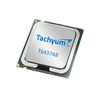Intel and Micron together announced the industrys first commercial quad-level cell (QLC) memory products, providing the highest density NAND components on the market.
The Japan Meteorological Agency (JMA) has installed two Cray XC50 supercomputers,further cementingCraysposition as the leading supplier of HPC systems forweather and climate centers.
Tachyum, a Silicon Valley startup has unveiled a new processor that the company says can tackle a broad range of workloads in HPC, data analytics, artificial intelligence, and web services, while using a fraction of the power of existing chips.
Intel has come up with a multi-chip module containing a Xeon Skylake processor integrated with an Arria 10 field programmable gate array (FPGA).
Episode 222: Addison Snell and Michael Feldman analyze new HPC installations in Italy, Belgium and Australia and predict where they may appear on next months TOP500 list.
The Pawsey Supercomputing Centre is expanding its Nimbus cloud service with NVIDIA V100 GPU-powered servers in order to provide additional capabilities for researchers.
The National University of Ireland (NUI) Galwayis getting ready to deploy a 5.4 million supercomputer, courtesy of the Science Foundation Ireland.
Google has demonstrated an artificial intelligence technology that represents the most sophisticated example to date of a computer engaging in natural conversation with a human. Upon hearing the interaction, some listeners felt the software had convincingly passed the Turing test.
At the Google I/O conference this week, CEO Sundar Pichai announced TPU 3.0, the third iteration of the companys Tensor Processing Unit, a custom-built processor for machine learning.
The National Supercomputer Centre (NSC) at Linkping University is gearing up to deploy a four-petaflop ClusterVision system, which will make it the most powerful supercomputer in Scandinavia.









